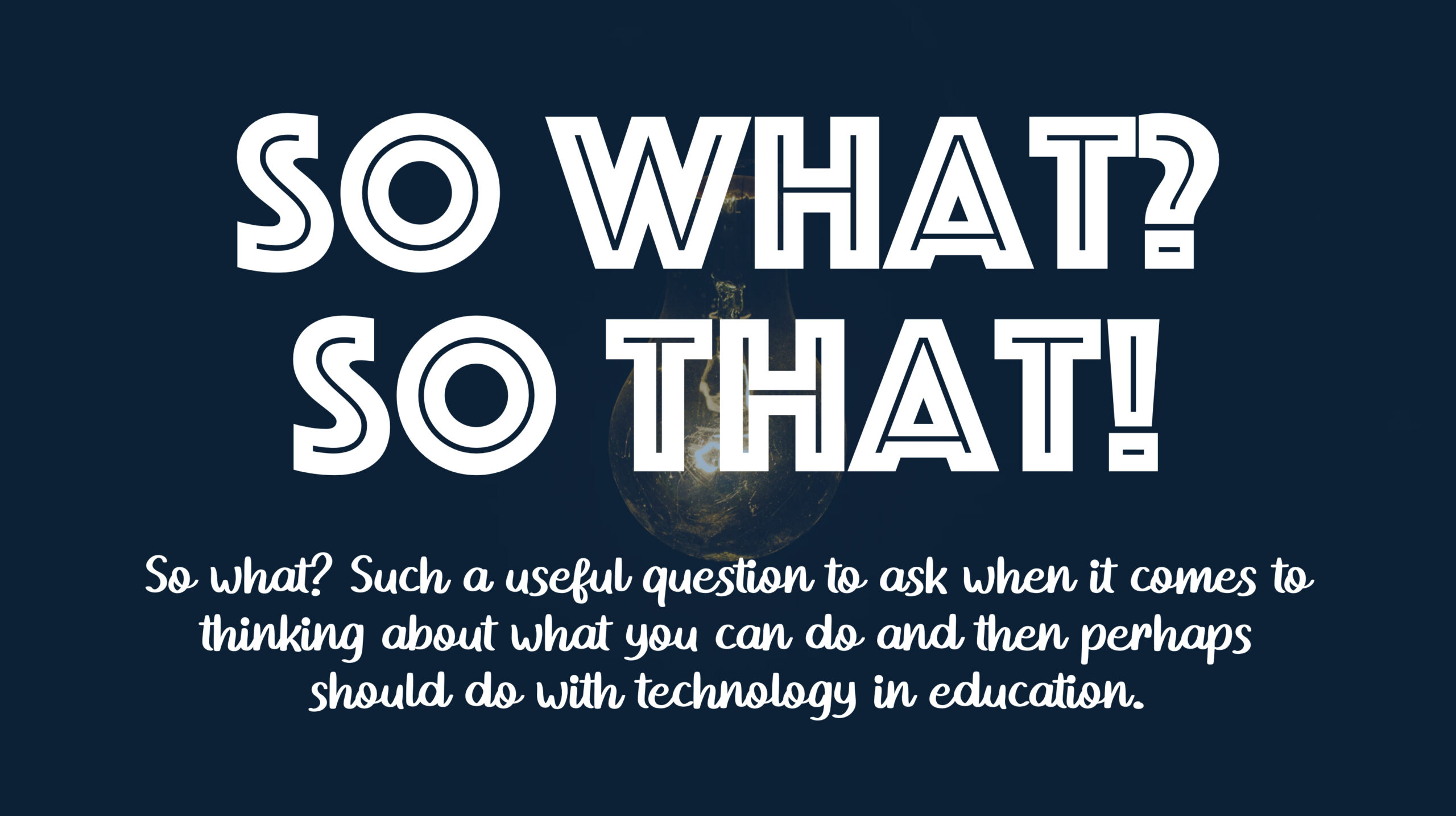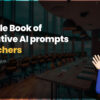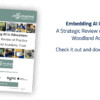
So what? Such a useful question to ask when it comes to thinking about what you can do and then perhaps should do with technology in education.
So much technology has a propensity to be gimmicky. It is a fine balancing act to choose between those activities with technology that can be supportive of learning and those which do little to help with learning other than the children might get to see you as the ‘fun’ teacher. That isn’t helpful to you as their teacher or to your learners, their learning, or your subject either for that matter!

Using technology as a gimmick devalues you as a teacher, devalues the technology and ultimately what you are doing in the classroom. Keep the depth of challenge and as I’ve shared for some time if your use of technology isn’t going to either:
a) Help you in the activity of teaching
b) Help them in the activity of learning
c) Help save time or create efficiencies
…then you probably will need to give a pretty strong argument for the use of technology in the context within what it is that you’re teaching.
Ruben Puentedura of the ‘SAMR’ framework notoriety says that at the redefinition level of the model, we should use technology to ‘do things that wouldn’t be possible if it wasn’t for the technology’. As I and others have written about before though, SAMR isn’t a ladder to climb and just because you can do something with technology, it doesn’t mean that you should. Equally, things that are seen as being substitution, such as note-taking digitally compared with by hand, can be really helpful, but it isn’t ‘redefinition’.
One of my key frameworks to help me with teaching and learning with technology has for a long time been the TPACK model of Koehler and Mishra (2009) which explains that good teaching and learning involves thinking about our content knowledge about what we are trying to teach, our pedagogical knowledge about the best ways to approach teaching that content and our technological knowledge – that technology which may be useful in delivering that particular content. Koehler and Mishra themselves said of their model that “TPACK is truly meaningful, deeply skilled teaching with or without (because sometimes this can be the best choice) technology.”

Credit: https://ictevangelist.com/technological-pedagogical-and-content-knowledge/
The tenet that has helped me for a long time to know whether I should or should not be using technology has been to consider the ‘so what’, ‘so that’, approach.
For example:
- I want to use animations in my presentations. So what? So that I can reduce extraneous cognitive load and introduce the right content on my slides at the right time to my learners.
- I want to use animations in my presentations. So what? So that they look prettier, and I think the animations and transitions are cool.
You can clearly see the difference.
Every child is different. Every class is different. Every school is different and therefore, with that in mind, being guided by your context and framing your thinking around this ‘so what’, ‘so that’ approach can help keep you on the right track with your choices around what you’re contemplating doing.
And if you can frame your ‘so that’ response around the idea that what you are choosing to do will either help you with teaching, help them with learning or save time or create efficiencies, you are more likely to be using technology for more purposeful reasons and hopefully start to see a return on your investment of using technology in the classroom.
So what?
Another piece of this puzzle is to remember that it is unlikely that one technology or use of technology by itself is unlikely to yield significant rewards. Yes, using dictation might help you write those reports more quickly or using keyboard shortcuts will make you more efficient or using a low-stakes quizzing tool such as Quizizz will reduce your marking load but these tools in isolation won’t make a huge impact overall.
Where we see impactful use of technology in education comes from the regular, informed and persistent use of a consistent set of tools and approaches adhered to and applied by all in a school.
As Hattie and others rightly point out in their work, collective teacher efficacy in your school is important and can have the highest impact in terms of raising standards across the board. The same is applicable in your use of technology.
Add to this the idea and thinking of Sir David Brailsford in relation to aggregated marginal gains; it is a joined-up approach with these consistently used tools and approaches that are applied by all, with confidence and competence that will make the difference to your strategic approach to teaching and learning with technology.
Former colleague, Zöe Elder took this idea into education with her marginal learning gains ideas and this ties in perfectly with this approach of looking carefully at your approaches to teaching and learning (with or without technology!) to decide upon these approaches.
So that!
One of the few benefits that the global pandemic has brought to education is the significant positive inroads that have been seen in relation to teacher confidence and competence in using technology.
Teachers haven’t been able to vote with their feet and choose to not use technology, but have been placed in the virtual deep end of the edtech swimming pool and have had to sink or swim. AS many would have guessed, teachers haven’t just floated but have swum and moved forwards years beyond where they might otherwise have been without the opportunity to use technology that the situation brought about. Plato said that “necessity is the mother of innovation” and it has been that requirement to push teachers out of their comfort zone to ensure the continuity of education in our schools that has helped move things forwards as much as they have.
In a recent #EdtechUAE conversation, educators asked the question, ‘How do we maintain the momentum?’ with these developments in confidence and competence in using technology. For me, the missing pieces of the jigsaw puzzle are outlined above.
- Keep the tenets of TPACK close to your heart
- Make sure you can clearly respond with a positive ‘so that’ response to your thinking about why you’re using technology
- Keep the three principles of whether that technology will either help with teaching, help with learning or bring efficiencies in your thinking
… and you won’t go far wrong!
Originally posted on the GESS website here.
If this post and approaches resonate with you, you can work with me. To find out more, drop me a line via my contact page where I’d be delighted to share how I can help you with your digital strategy, curriculum and teaching and learning with technology.














